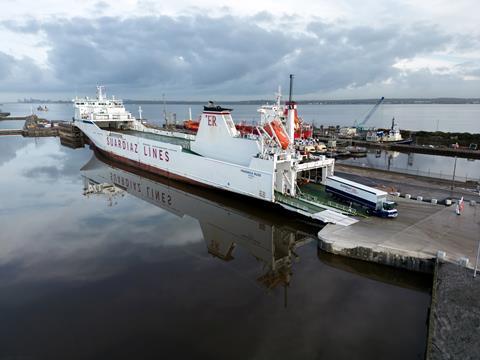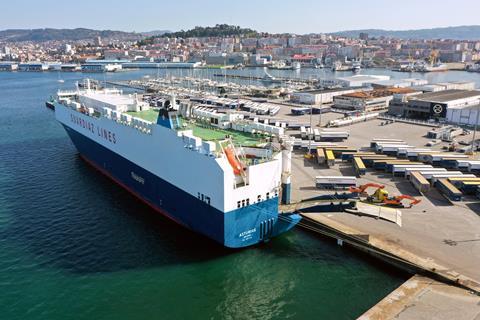This content was produced by Automotive Logistics in partnership with Suardiaz Group
Customised integral logistics provider Suardiaz is making its inbound and finished vehicle logistics services more sustainable through a combination of new truck and vessel technology, optimised route planning, including mixed short-sea loads, and the adoption of alternative fuels.
Suardiaz is providing multimodal services combining shortsea and road freight services for a number of European vehicle makers. Over the past year it has been ramping up an inbound service for Stellantis bringing in different parts and components from Spain by shortsea via the port of Vigo for delivery to the Stellantis van factory at Ellesmere Port near Liverpool, UK. Currently providing one vessel departure per week, that will increase to a twice-weekly maritime route next year feeding the hub Suardiaz has set up with Peel Ports in the UK. It will take an estimated 14,700 lorry journeys off the roads between Spain and the UK, saving approximately 17.5m km of road travel and reducing CO2 emissions by 30%.

Suardiaz says that it aims to include return hauls of finished vehicles to Spain as soon as production increases and exports are set up for the Spanish market.
The company has a similar service between the port of Vigo and St Nazaire port in France, with parts and finished vehicles going in both directions on a twice-weekly service for factories in Vigo and Rennes, as well as for vehicle distribution. As with the Stellantis service between Spain and the UK, the Spain-France route is taking freight off the roads and saving 30% in CO2 emissions.
Suardiaz has also been able to offer multimodal services between Morocco and Europe (including France, Spain and Portugal) for Stellantis and Renault, among other carmakers.
Being able to move trailers and finished vehicles with the same vessel requires that vessel be flexible enough. Suardiaz deploys ro-ro carriers with hoistable decks enabling them to carry volumes of finished vehicles and truck trailers. The benefit of being able to combine trailers and cars is that Suardiaz can increase service frequency by putting both types of cargo on the same vessel, increasing the volume. The advantage for the customer, is having more departures available for timely deliveries.
Balancing multimodal volumes
Volume is one of the main things to consider when establishing a multimodal service, according to Suardiaz. Without a balance of volumes it is extremely difficult to justify a multimodal solution. The critical point is to be able to find enough volume on a certain route so the multimodal solution can be justified.

Planning for that is made problematic by volatility in the supply chain, something that more flexible production at the OEM plants feeds into. This production flexibility at the assembly factories affects logistics providers because volumes can change in a very short period of time. Volatility can cause disruption making accuracy of forecasts a challenge.
That can mean resort to road freight when shipments are urgent, and Suardiaz offers an international truck service. The company says it is compatible having 80% of the volume shipped on multimodal routes while retaining 20% for those special cases where road can still be competitive and flexible enough to adapt to the specific needs of each customer. Suardiaz says it is more sustainable in the sense that the CO2 emissions are heavily reduced while remaining compatible with road freight planned along optimised routes that reduce mileage.
What is important in providing these services, often at short notice, is close communication with the OEM customers and their planning teams. Transport providers need to know as soon as possible about volume fluctuations to install contingencies to overcome them. With that information Suardiaz can combine several customers onto the same vessel to mitigate volume fluctuations. Working together with them, the logistics provider can adjust the frequency or lead times, levelling out peaks that volatile production occasionally throws up. Logistics providers have to be ready to increase or reduce capacity and frequency, but that needs to be balanced with the minimum critical volume required for multimodal transport.
Vessel improvements for lower emissions
In support of its optimised multimodal services Suardiaz is investing in a range of technology to further decarbonise services and meet regulations in Europe. Those regulations include the EU Emissions Trading System, which requires companies to pay for the greenhouse gas emissions they produce. There is also a new regulation due on EU maritime fuel which will necessitate the use of some biofuels from 2025, with which Suardiaz will also comply.
Ships operating in the Mediterranean will also soon have to comply with the sulphur regulations that currently apply in northern European waters. As of 1 May 2025, the Mediterranean Sea will effectively become an Emission Control Area (ECA) for sulphur oxides (SOx) under Marpol Annex VI Regulation 14. Suardiaz has committed to reducing sulphur emissions from its vessels in line with the new regulation. It says that such regulations push maritime logistics operators to innovate with the technology used on board their vessels and forward their administrative compliance.

Suardiaz is also investing in larger vessels that have better emissions performance per vehicle unit transported for short term efficiency gains.
Amongst the other technologies it is using, for example, is a new smart coating on the hulls of its shortsea vessels that reduces friction and therefore saves on fuel consumption, while improving efficiency by 4-5%. It is also installing new propeller technology on those vessels, which improves the efficiency by a further 5-6%, again, reducing fuel consumption. Suardiaz is installing the new propellers on all of its vessels as they come in for routine maintenance.
Suardiaz is also working together with port authorities, including at the port of Vigo, Liverpool and Saint Nazaire, to run vessels at berth with electricity from landside – also known as cold ironing or OPS (on-shore power supply) – rather than running vessel engines, thereby reducing CO2 emissions while at port. However, that depends on existing port infrastructure. Both Liverpool, Nantes and Vigo are working on being able to provide electricity so that vessels can plug-in to the electricity grid onshore when at port.
On land, Suardiaz is collaborating with several customers to provide last-mile delivery services using electric trucks to transport materials from the port to the assembly plant, further reducing the carbon footprint of the supply chain. That requires charging points at the ports and the factories. Infrastructure improvements also need to be made to support the use of longer distance electric truck transport but in the meantime Suardiaz is optimising road routes to cut distances and building in multimodal options that use short-sea and road, all designed to reduce emissions.

The company is also embracing digital technology to provide a more efficient service for customers and more accurately track the location of its trailers, whether on road or shipping by shortsea vessel. Suardiaz services are fully integrated with the IT system of its customer via a platform that provides it with transport orders. The logistics provider can confirm availability and transport option, as well as process invoicing in real-time using the platform, which makes everything more efficient and avoids human error.
Suardiaz has installed GPS devices on all of its trailers so that it can detect where its trailers are and manage the fleet more effectively. The GPS device enables the company to foresee whether a certain unit will make it on time for a particular shipment or it will have to be postponed for the next one. That, combined with connection it has with the OEM customer platform means it can inform the customer well in advance of the arrival of the shipment. The GPS and platform are also helping Suardiaz to manage the pool of trailers, make deployment more efficient and reduce risk.






































No comments yet